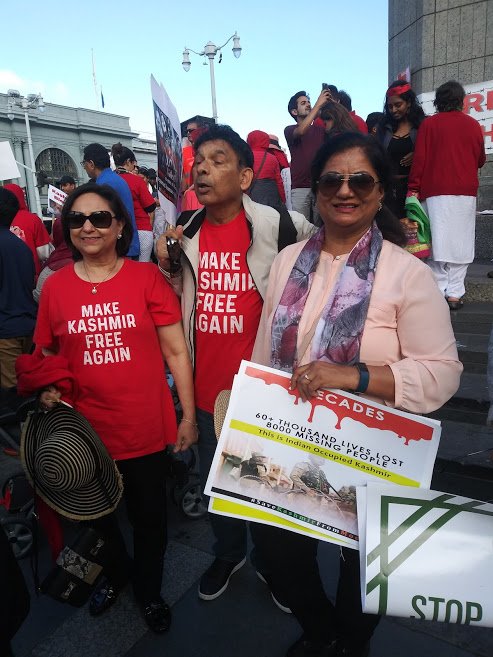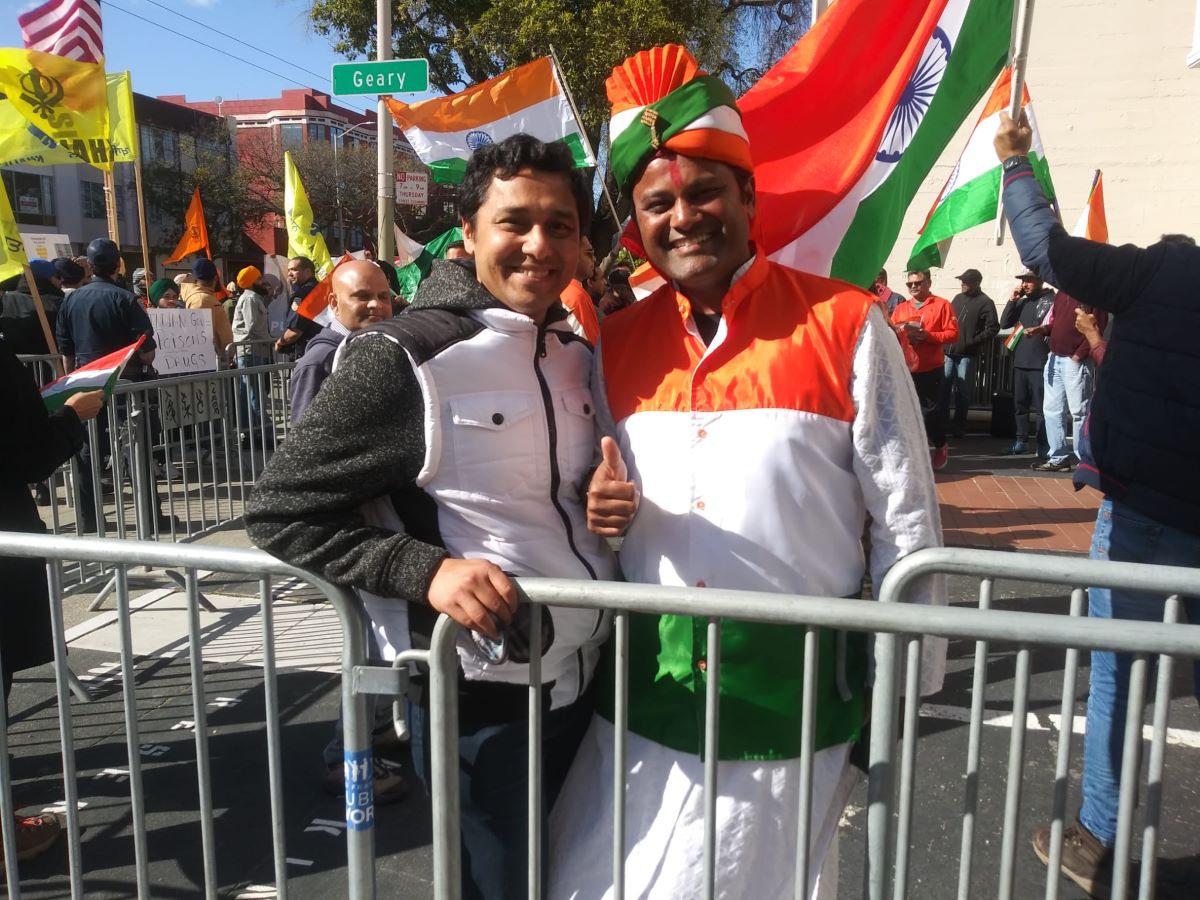SAN FRANCISCO, California — A scene on the streets here last month viscerally depicted the current deep divide and polarization of the Indian American community.
In front of the San Francisco Indian Consulate, police officers had set up a line of barricades. On one side of the divide, close to the consulate office, were about 150 people — including many supporters of the BJP, Prime Minister Narendra Modi’s party, which is often characterized as a Hindu nationalist movement — showing their support for the consulate, which had been vandalized five days earlier by other Indians who are supporters of a movement to create an independent country, Khalistan, out of the Indian state of Punjab.
Five days earlier, the Khalistanis had smashed through consulate windows with their swords, known as kirpans. Bits of shattered glass hurt two workers inside the building. The group then set up tents outside the building to spend a week-long vigil protesting the Indian government’s abrupt shut-off of the Internet across Punjab, and the allegedly unlawful detention of 100 Khalistani supporters, who are being held indefinitely without charges.
Over the past five years, the Indian American community has taken part in similar clashes, most recently over the furious debate to add caste as a protected class, first in Seattle, Washington, where the measure sponsored by city council member Kshama Sawant passed, and now in the California state Assembly with a bill sponsored by freshman Assembly member Aisha Wahab.
The Politics of Division

The Indian American community also clashed in August 2019 as the Modi government revoked Article 370 from the Indian Constitution. Article 370 had previously given the states of Jammu and Kashmir special autonomous status. The Indian government abruptly revoked Article 370, instituting curfews and cutting off the Internet and telephones, leaving Kashmiris unable to connect with the outside world. Protesters and supporters gathered around the world. In San Francisco, a group of more than 1,000 people stood outside the iconic Ferry Building, tearfully recalling their fright over being unable to connect with relatives. And in a separate action, supporters — many of whom were forced to flee Jammu and Kashmir in 1989 — gathered for a candlelight vigil in front of San Jose, California’s City Hall to note they would finally be able to return home.
The tension has resulted in intra-ethnic violence within the Indian American community. Last August, Fremont, California resident Krishnan Iyer was picking up dinner at a local Taco Bell when a fellow Indian, Tejinder Singh confronted him with a long anti-Hindu tirade. Singh was arrested and charged with a hate crime, but received a diversion sentence in which he will serve no jail time.
Hindu Nationalism
“I was just in India in February and March, and I don’t think I have seen India more divided and polarized,” anthropologist Dr. Thomas Blom Hansen, Director of Stanford University’s Center for South Asia, told Ethnic Media Services in an interview. “It is the Hindu nationalist movement across the world that has done this.”

Blom Hansen is the Reliance-Dhirubhai Ambani Professor in South Asian Studies at Stanford and Professor in Anthropology. He is the author of several books dissecting the politics of South Asia, including “The Saffron Wave,” and more recently, “The Law of Force: The Violent Heart of Indian Politics.” In an April 20 interview with EMS, Blom Hansen discussed the deep fissure currently driving the Indian American community. Here are excerpts:
EMS: Have you ever seen the tensions of the Indian American community surface in this way, in the past?
Blom Hansen: No. And also the fact that people who are supporting the ruling party are showing up to show their support for the state, is something that’s new. We see the celebration of the military and celebration of the institutions of the state, especially the repressive arm of the state. That’s a new thing. Even during the height of Congress party rule and sort of unprecedented dominance of Indian politics, we never saw ordinary citizens coming out in active support of state institutions. This is unprecedented.
I think this is a bigger shift and that is maybe what worries me the most.
EMS: And do you credit the Modi government with fomenting this rise in polarization within our community?
Blom Hansen: Absolutely. But it’s not just the Modi government. It’s the Hindu nationalist movement across the world that has done this. They thrive on controversy and polarization. That’s the only climate that makes it work for them. Because only in that climate can they claim that the nation is in danger. We have to protect it from internal enemies.
So the Khalistanis, their demands and their emotions notwithstanding, they kind of play into this, showing that the Hindu majority is under constant pressure and under threat and we have to mobilize and be vigilant.
And of course, it’s harder now that they’re in total control: how do you then produce enemies? But they constantly do; there’s always something. The overreaction in the case of this BBC documentary was a case in point; the sort of completely shrill rhetoric around this that you can’t even produce journalism without being a colonialist.
(EMS note: In January, the BBC released a three-part documentary: “India: the Modi Question.”)
EMS: Caste has become a very divisive issue in our community. Are the politics of the home country somehow activating people who’ve always considered themselves on the margins of our community, to feel empowered to bring up these issues now?
Blom Hansen: Some of it has to do with political mobilization. The BJP is very aware of this and has done a lot to sort of reach out and try to mobilize and get support from Dalit communities. But Dalit communities as a whole, although they are very divided politically, but they are much more mobilized today than they ever were before.
The Cisco case was really important. This caste discrimination case was the first in an American courtroom. And although the case failed, it raised the possibility that one could think of caste as a protected category.
EMS: As an anthropologist, how do you see us moving beyond this polarization? Do you have hope for the next generation moving away from the politics of the home country and forging an Indian American culture here?
Blom Hansen: Well, I’m very hopeful. I’m very impressed with many of the young people who are driving these initiatives and engaging in introspection. The participation of many young Indians in the Black Lives Matter movement and so on, I take that as a hugely positive sign for the young generation.
But there are also lots of young people that are on the other side who are students or second generation who are brought into this concept of Hindutva and for whom it’s important for their American identity, their hyphenated identity, that India is seen as a strong and powerful country in the world and that India as a mother of democracy and India as Vishwaguru, the teacher of the world.





